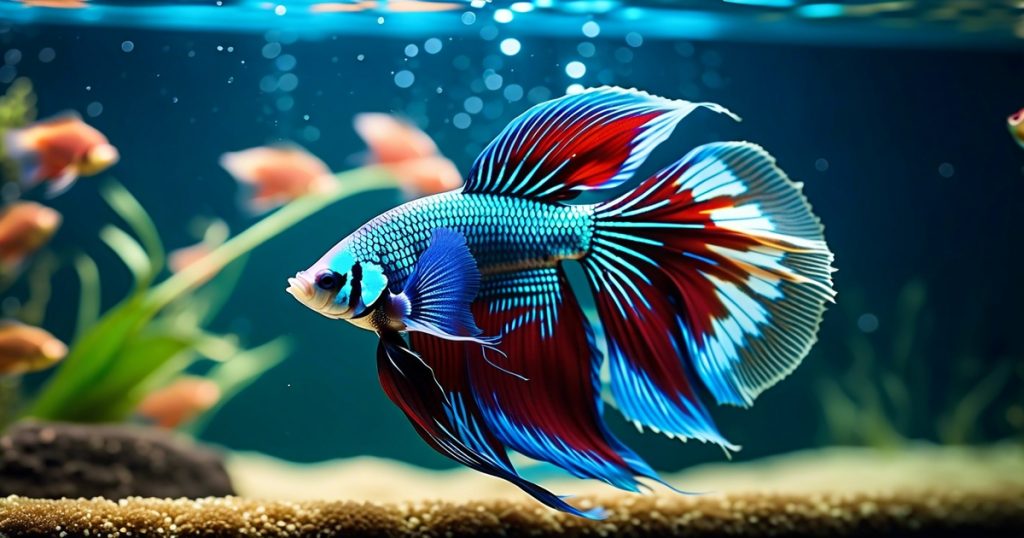Ever wondered how betta fish manage to mate without turning their courtship into a battle royale? It’s a fascinating phenomenon that captivates many fish enthusiasts. Understanding the intricacies of this unique mating process sheds light on the delicate balance between aggression and reproduction in these stunning aquatic creatures, betta fish mate.
Join us as we dive into the world of betta fish courtship, exploring the surprising strategies they employ to ensure successful mating without causing harm. Get ready to unravel the mystery behind how betta fish navigate romance during mating season amidst their feisty nature.
Table of Contents
ToggleIdentifying Male and Female Betta Fish

Physical Characteristics
Male betta fish can be identified by their longer fins and brighter colors. They often have flowing, elaborate fins that come in a variety of vibrant hues like red or blue. On the other hand, females typically have shorter fins and are generally less colorful compared to their male counterparts.
Female bettas also possess a distinct physical feature known as an egg spot, which is located on their bellies. The small white dot resembles a grain of salt and is an indicator that the betta fish is female.
When observing a group of betta fish, it’s important to pay close attention to these physical characteristics such as fins in order to correctly identify the males from the females.
Behavioral Cues
Aside from physical traits like fins, there are behavioral cues that can help distinguish between male and female bettas. During mating rituals, male bettas exhibit aggressive behavior towards each other but display courting behaviors when paired with females.
For instance, betta may flare out their gills and spread their fins wide while swimming around the female. In contrast, female bettas tend to be less aggressive towards each other and may show submissive behavior when approached by males for mating purposes.
Understanding both the physical characteristics and behavioral cues, as well as eggs, is crucial for successfully identifying male and female betta fish within a shared habitat.
Signs of Betta Fish Mating Readiness
Vertical Stripes on Female Betta’s Body
Female bettas ready to mate may develop vertical stripes on their bodies. This is a clear sign that the female betta is in breeding condition and receptive to the male’s advances. When you notice these vertical stripes, it indicates that the female betta fish is preparing for mating.
Male bettas are known to exhibit aggressive behavior towards females at times, especially when they are not ready to breed. However, once a female betta shows these vertical stripes, it signals her readiness for mating and reduces the likelihood of aggression from the male.
Bubble Nests as an Indicator
When male bettas are prepared to mate, they often build bubble nests at the water’s surface. These nests resemble clusters of bubbles adhering together and can vary in size depending on how eager the male betta is to reproduce.
The presence of a betta bubble nest signifies that the male has entered his reproductive phase and is actively seeking a partner for spawning. It also serves as a safe space where fertilized eggs will be stored after mating occurs.
Increased Activity and Vibrant Colors
Both male and female bettas undergo noticeable behavioral changes when they’re ready to mate. They become more active than usual, swimming around energetically as part of their betta courtship rituals. Their colors intensify significantly during this period; males display brighter hues while females may show more vivid pigmentation.
These vibrant betta displays serve as visual cues indicating their receptiveness towards potential mates within their environment.
Creating a Suitable Habitat for Breeding Bettas
Separate Breeding Tank
When breeding betta fish, it’s crucial to use a separate tank. This provides the male and female bettas with their own space, reducing aggression. The betta tank should have plenty of hiding places like caves or plants to minimize stress and conflict.
It’s essential to keep the betta breeding tank at an optimal temperature between 78-80°F (25-27°C). Maintaining warm water conditions is vital for stimulating mating behavior in betta fish. A consistent and suitable temperature creates a comfortable environment for successful betta mating.
Providing Spawning Sites
Adding broad-leaved plants or a spawning mop in the breeding tank is important when preparing for betta fish mating. These items provide surfaces where the female betta can lay her eggs while allowing easy access for the male to fertilize them. They also mimic natural environments, increasing the chances of successful egg laying and hatching.
Creating bubble nests by using floating materials like styrofoam can encourage courtship behaviors from male bettas towards females. These nests are used by male bettas during courtship as well as after spawning occurs, providing protection for fertilized eggs until they hatch.
Introducing Male and Female Bettas Safely
Separate Compartments
When breeding betta fish, it’s crucial to keep the male and female in separate tanks within the breeding tank. This prevents them from attacking each other prematurely. By providing separate spaces, you give betta time to get used to each other’s presence without any direct contact.
It’s like inviting two friends who have never met before to a party but seating them at different tables first. This way, betta can observe each other from a distance and gradually become comfortable with the idea of interacting.
Gradual Introduction
Once both bettas show signs of readiness to mate, such as vertical stripes on their bodies or bubble nest building by the male, you can start removing the dividers between their compartments. This gradual introduction allows betta to acclimate to each other’s presence without feeling threatened or territorial.
Imagine it as introducing two shy people who are interested in getting to know each other. You wouldn’t want to rush things and throw them into a conversation right away; instead, you’d create opportunities for casual interactions until they feel at ease with one another.
Observing Bettas’ Actions During Mating
Male’s Attempt to Lead Female to the Bubble Nest
Male bettas are responsible for building bubble nests, which they create by using saliva and air bubbles. During the mating season, male bettas will entice females towards these nests as part of their courtship behavior. They do this by swimming in a zigzag pattern, showing off their vibrant colors and displaying vertical stripes on their bodies.
The male’s goal is to persuade the female to approach and inspect the bubble nest. This process can take time, as some females may be initially hesitant or uninterested. However, once convinced, the female will swim closer to investigate.
Once near the nest, if she approves of it, she will then signal her readiness for mating by assuming a head-down position with her body bent slightly upward.
The “Embrace” and Egg Fertilization
In an intricate dance-like maneuver known as an “embrace,” the male wraps himself around the female in a display of affection that also serves to release his sperm into the water. This allows for fertilization of the eggs that have been released by the female through her ovipositor.
After fertilization occurs, it is essential for breeders or observers not to interfere with this delicate process. The male should remain close at hand during this time since he plays an active role in protecting both eggs and fry after hatching.
Preventing Aggression During Betta Fish Mating
Remove Either Fish
If the fight between the betta fish becomes too intense during mating, it’s essential to remove one of them from the tank. This can prevent serious injury or even death. If you notice excessive aggression, separate the pair and reintroduce them after a few days.
It’s important to remember that male bettas are territorial and may become aggressive towards each other during mating. Removing one fish temporarily can help diffuse tension and prevent harm.
Provide Hiding Spots
To minimize aggressive behavior during mating, ensure there are plenty of hiding spots in the tank for both bettas. These spots can be created using plants, decorations, or caves. The hiding spots offer refuge for either fish if they feel threatened or overwhelmed by their mate.
Hiding spots provide a sense of security for bettas as they navigate through courtship and mating rituals. They also serve as retreats where a submissive fish can escape an aggressive partner when necessary.
Caring for Betta Fry Post-Mating
Separating the Fry
Once the offspring of betta fish become free-swimming, it’s crucial to separate them from the parents. This is because adult bettas have a tendency to be aggressive towards their own fry. By moving the fry to a separate tank, you can ensure their safety and allow them to grow without fear of being attacked by their parents.
It’s important to create an environment where the fry can thrive without any threat from adult bettas. Providing them with a separate space allows you to closely monitor their growth and development without interference or potential harm.
Feeding the Fry
Feeding your betta fry multiple times a day is essential for their healthy growth. Consider feeding them specialized fry food or infusoria, which are tiny aquatic organisms that serve as excellent nutrition for young fish. These foods are rich in essential nutrients that support proper development during this critical stage.
Consistent feeding ensures that the offspring receive all the necessary nutrients they need to grow into healthy adult bettas. It’s important to maintain a strict feeding schedule and provide small portions each time, ensuring that none of it goes uneaten and pollutes the water.
Maintaining clean water conditions is vital for ensuring optimal health in growing betta fry. Regularly changing a portion of the water helps remove waste and prevents harmful substances from accumulating in the tank, promoting good health among your offspring.
Closing Thoughts
You’ve now learned the ins and outs of how betta fish mate without harming each other. By understanding their behaviors, creating a suitable breeding environment, and carefully introducing them, you can ensure a safe and successful mating process for your bettas. Remember to keep a close eye on them during the mating period and provide proper care for the fry post-mating.
Now it’s time to put your knowledge into action and create the perfect conditions for your betta fish to mate successfully. Get ready to witness the beauty of nature as your bettas engage in their natural mating behaviors. With the right approach, you can play a crucial role in facilitating a safe and harmonious mating process for these stunning aquatic creatures.
